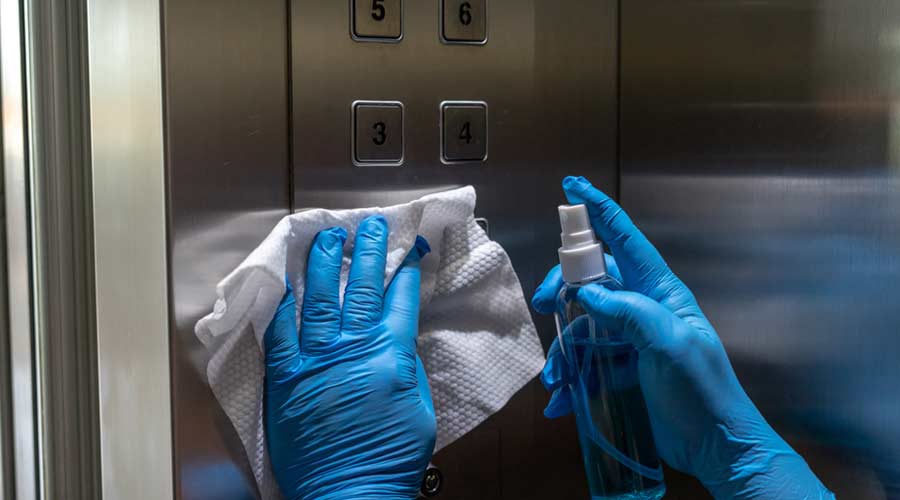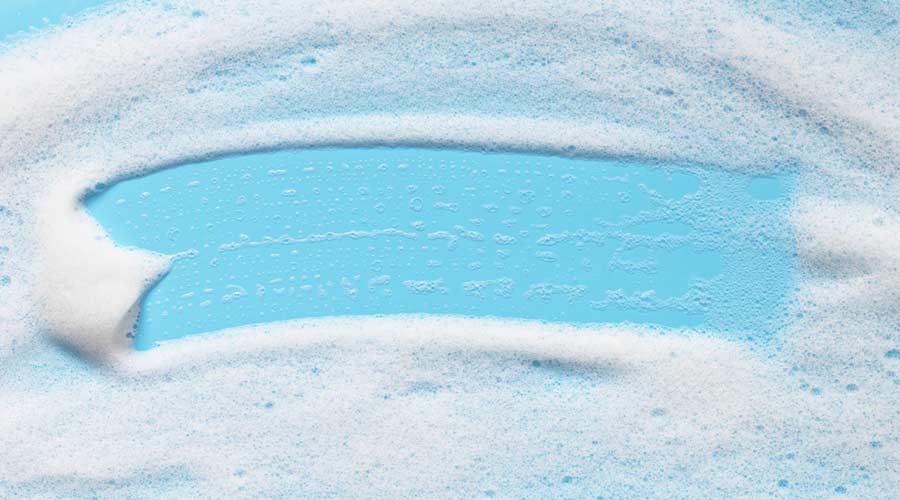
By Keith Schneringer, Senior Director of Marketing Jan/San + Sustainability for BradyPLUS
Have you ever driven past a commercial office building at night and seen all of the lights lit up into the wee hours of the morning? Have you ever wondered what was happening in that building, and whether or not all of the employees were working late? The simple answer is yes; the employees are working late, but just not the ones you may have been thinking about. More than likely, the lights are on in that building so that the custodial staff employees working at night can do their jobs.
But what if these cleaning tasks could all be performed during the day? What if instead of lighting up the office building at night so it can be cleaned, the lights only had to be on during the day while all the office employees were there too? What if you could switch off the lights at night by switching from cleaning at night to day cleaning?
Once considered impractical or intrusive, day cleaning continues to attract proponents as cleaning technologies advance and organizations recognize its multifaceted benefits. From energy efficiency and cost savings to improved building security and employee morale, the advantages of transitioning from nighttime cleaning to daytime operations are both immediate and long-term. And that is why more and more facilities — especially commercial office buildings, schools, and government buildings — are making the switch.
What is Day Cleaning?
Day cleaning refers to the practice of performing janitorial and cleaning tasks during “regular” daytime business hours, typically between 7 a.m. and 5 p.m., rather than after hours. These cleaning tasks include vacuuming, dusting, trash removal, restroom maintenance, general surface cleaning, and floor care, among other scheduled tasks — all while tenants or employees are still occupying the space during the day. While it may sound counterintuitive to clean a busy workplace during business hours, advancements in quiet-cleaning equipment, low-VOC cleaning chemicals, better planning, and more effective communication have all combined to help make it a viable and even preferred option for many facilities.
Benefits of Day Cleaning
One of the most compelling arguments for day cleaning is its environmental and financial impact, particularly in the area of energy consumption. As discussed earlier, traditionally, buildings remain fully lit, heated, or cooled during nighttime cleaning shifts — sometimes for only a small number of janitorial staff. This practice results in largely unnecessary energy use.
By cleaning during daylight hours, buildings can reduce the duration of lighting and HVAC operation. A study by the Building Owners and Managers Association (BOMA) estimated that day cleaning can reduce energy consumption by four to eight percent. These numbers add up quickly for large commercial buildings, leading to significant annual savings, reduced energy consumption, and by extension, a smaller carbon footprint.
Organizations aiming to meet green building standards such as ENERGY STAR and LEED often find that day cleaning supports their sustainability goals in ways they can measure in the form of decreased energy usage.
Energy savings are just one piece of the cost-reduction puzzle. Day cleaning can also lead to lower overall operational expenses in other ways:
- Reduced Security Needs: With janitorial work happening during the day, there’s less need to keep buildings open and guarded after hours. This decreased need can translate to fewer security staff hours and a lower risk of unauthorized access.
- Better retention and lower turnover: Day shifts are frequently more attractive to cleaning staff. Janitors working during the day can potentially maintain a better work-life balance, reducing turnover – a major hidden cost in the cleaning industry.
- Efficient supervision: Supervisors and facility managers are usually on-site during the day, which makes it easier to train staff, monitor performance, and resolve issues quickly. This improves productivity and service quality.
Enhanced Building Security
Keeping a building secure after hours for any reason can be both a logistical and a financial challenge.
With night cleaning, doors are often left unlocked or opened repeatedly for staff to enter or exit, creating potential vulnerabilities. If no tenants are present, a relatively empty building can become a target for theft or vandalism. And then guess who frequently gets blamed for the missing items? The “night custodian” who is unknown to the daytime workers in the building since they work at night when nobody else is there and are therefore a much easier target than their co-worker in accounting who really is the prime suspect all along.
Day cleaning helps to mitigate building security risks. Cleaning staff work alongside other employees or tenants in a building that is already occupied and secured. This arrangement reduces the potential risk of unauthorized access and enhances overall security.
Improved Staff Morale + Retention
It is no secret that the cleaning industry faces chronically high turnover, often due to undesirable working conditions such as overnight hours and physical isolation. By offering daytime work, employers can make the job potentially more appealing.
Workers who clean during the day benefit from:
- More regular sleep schedules.
- Safer working environments, including better lighting and emergency support.
- More interaction and recognition from building occupants.
When cleaning staff are seen as part of the workplace community rather than invisible background labor after hours, morale improves. This improved morale fosters a sense of pride and professionalism in their work, which can lead to better performance and cleaner spaces. Oh, and also now any items that go missing won’t automatically be blamed on the cleaning staff anymore!
Cleaner Buildings and Higher Accountability
Day cleaning introduces a level of visibility and accountability that nighttime operations can lack. Because cleaning is done in real-time while the space is in use, building occupants can immediately provide feedback or request specific services. For example:
- Overflowing trash can be addressed on the spot.
- Spills or hazards are dealt with before they become problems.
- Restrooms can be maintained throughout the day, not just at night.
This visibility not only improves service quality but also encourages cleaning staff to maintain higher standards. Occupants are more likely to respect and maintain a clean space when they see it being actively cared for.
Improved Workplace Health + Hygiene
Hygiene and cleanliness remain top-of-mind concerns for both employees and employers — especially in a post-pandemic world. With cleaning occurring throughout the day, touchpoints like door handles, elevator buttons, and shared workspaces can be sanitized multiple times daily instead of just once at night. This continuous attention to hygiene helps reduce the spread of germs and supports a healthier workplace. Reduced absenteeism due to illness can boost productivity and employee well-being.
Better Integration with Facility Management
Day cleaning also enables more seamless integration between cleaning teams and facility management. Because both groups are working the same hours, there are more opportunities for collaboration, inspections, and proactive maintenance. For example:
- Building managers can give real-time direction to cleaning teams.
- Maintenance requests can be escalated and resolved more quickly.
- Cleaning crews can assist in identifying wear-and-tear issues early.
This close coordination leads to more efficient operations and better long-term outcomes for the facility.
Shifts in Culture + Perception
Historically, cleaning has been viewed as a behind-the-scenes function, best kept out of sight. However, modern workplace culture is increasingly embracing transparency and inclusiveness. Day cleaning reflects this shift. Employees and visitors who witness cleaning taking place throughout the day are reminded that cleanliness and safety are valued organizational priorities. This visibility can change perceptions of janitorial work and foster a greater appreciation for those who keep the space clean and safe. Moreover, companies that highlight their use of day cleaning as part of sustainability and wellness initiatives often find it enhances their brand reputation — particularly among environmentally and socially conscious stakeholders.
Overcoming Challenges
Despite its many benefits, day cleaning is not without challenges. Common concerns include:
- Disruption of work activities.
- Noise from vacuums or equipment.
- Privacy in sensitive office areas.
However, these issues are often manageable with proper planning. Solutions include:
- Using low-decibel “quiet” vacuums, microfiber tools, and low-VOC cleaning chemicals.
- Training staff to be discreet and courteous.
- Establishing cleaning schedules that avoid peak productivity times.
- Communicating cleaning zones and times to occupants.
Many facilities have successfully adopted hybrid models, where routine tasks are handled during the day and deeper cleaning is reserved for occasional off-hours work.
Final Thoughts
Day cleaning can represent a paradigm shift in how we approach cleaning. Far from being a mere cost-cutting trend, it offers a holistic improvement in sustainability, safety, staff welfare, and operational efficiency. As more organizations strive to meet sustainability initiatives, reduce overhead costs, and foster healthier building environments, the case for day cleaning becomes even more compelling.
Facilities that embrace this change not only benefit in the short term but also position themselves as forward-thinking, responsible stewards of their spaces. With the right planning and commitment, day cleaning is not just possible — it’s a smarter way to clean.
Interested in making a switch?
Keith Schneringer has been in the sanitary supply industry since 1990 and is currently the Senior Director of Marketing Jan/San + Sustainability for BradyPLUS, a specialized distributor and solution provider in facility care, foodservice, and industrial packaging. In his current role, Keith is responsible for marketing to the jan/san and facility care industry, for developing vertical-market-specific programs to better assist customers, and for leading the company's sustainability initiatives. Before assuming his current responsibilities, he worked as an account consultant, sales manager, marketing manager, and director of channel marketing + sustainability for WAXIE Sanitary Supply.
posted on 7/1/2025

 The Down and Dirty on Cleaning in Virus Season
The Down and Dirty on Cleaning in Virus Season How Surfactant Use is Expanding in Commercial Cleaning
How Surfactant Use is Expanding in Commercial Cleaning